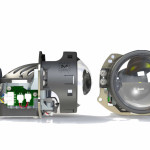
In the world of 4x4 vehicles, the pursuit of optimal performance is an ongoing quest. One of the key factors that can significantly impact an engine's power output and efficiency is the interplay between the exhaust and intake systems. This article delves into the correlation between larger exhaust and intake systems, exploring how they can enhance the performance of a 4x4 vehicle. By understanding the science behind this relationship, off-road enthusiasts can make informed decisions to maximize their vehicle's potential.
The Engine's Respiratory System: Intake and Exhaust
At the heart of every internal combustion engine lies a sophisticated respiratory system: the intake and exhaust systems. The intake system draws in fresh air, allowing oxygen to mix with fuel for combustion, while the exhaust system expels the byproducts of combustion, such as carbon dioxide and unburned hydrocarbons. The efficiency of these systems directly impacts an engine's power output, fuel efficiency, and overall performance.
The Correlation Between Exhaust and Intake
The correlation between the size of the exhaust and intake systems lies in achieving a balance between them. Increasing the size of either system without considering the other can lead to imbalances that hinder performance. When both systems are optimized in harmony, they can work together to improve a 4x4 vehicle's power delivery and overall efficiency.
Larger Intake System: More Air, More Power?
A larger intake system allows a greater volume of air to enter the engine, facilitating improved combustion. When more oxygen is available, the engine can burn fuel more efficiently, resulting in increased power output. However, it's important to note that simply enlarging the intake can lead to unintended consequences. If the intake is too large, it can negatively affect the air velocity, potentially leading to reduced low-end torque and responsiveness.
Larger Exhaust System: The Art of Efficient Expulsion
Similarly, a larger exhaust system can offer benefits when properly tuned. A more efficient exhaust system reduces backpressure, allowing the engine to expel exhaust gases more easily. This can lead to increased horsepower and torque, as well as improved fuel efficiency. However, an exhaust system that is too large can result in lost exhaust gas velocity, leading to a decrease in overall power and responsiveness.
Synergy Between Exhaust and Intake Systems
The real magic happens when the exhaust and intake systems are carefully balanced to complement each other. A larger exhaust system that reduces backpressure, combined with a larger intake system that maintains optimal air velocity, creates a harmonious environment for the engine to operate at its peak performance. The synergy between the two systems enables improved power delivery across a wider RPM range, making the vehicle more capable both on and off the road.
Real-World Performance
In a 4x4 vehicle scenario, the correlation between larger exhaust and intake systems can be seen in various performance metrics. Off-road enthusiasts often seek enhanced low-end torque for better crawling and ascending capabilities. A well-balanced exhaust and intake system can provide the necessary torque at lower RPMs, making tackling challenging terrains a smoother experience.
Additionally, when traversing rough terrains or towing heavy loads, the increased power and torque gained from optimizing these systems can significantly enhance the vehicle's capability. However, it's important to note that modifications should be done carefully, and a professional tuner's expertise can help strike the perfect balance between the two systems for optimal performance.
Conclusion
The correlation between larger exhaust and intake systems for 4x4 vehicle performance is not just a matter of increasing size, but rather achieving a delicate balance between these components. When done correctly, a larger intake system and a properly tuned exhaust system can work in harmony to unlock a 4x4 vehicle's true potential. The result is improved power output, enhanced torque delivery, and better overall efficiency, making off-road adventures more thrilling and capable than ever before. Off-road enthusiasts looking to unleash their vehicle's power should approach modifications with a thorough understanding of this intricate relationship for the best results.














































































-1000x1000w-150x150.jpg)
-1000x1000w-150x150.jpg)







Leave a comment